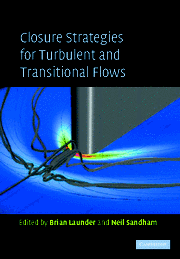1 - Linear and Nonlinear Eddy Viscosity Models
Published online by Cambridge University Press: 06 July 2010
Summary
Introduction
Even with the advent of a new generation of vector and now parallel processors, the direct simulation of complex turbulent flows is not possible and will not be for the foreseeable future. The problem is simply the inability to resolve all the component scales within the turbulent flow.
In the context of scale modeling, the most direct approach is offered by the partitioning of the flow field into a mean and fluctuating part (Reynolds 1895). This process, known as a Reynolds decomposition, leads to a set of Reynoldsaveraged Navier–Stokes (RANS) equations. Although this process eliminates the need to completely resolve the turbulent motion, its drawback is that unknown single-point, higher-order correlations appear in both the mean and turbulent equations. The need to model these correlations is the well-known ‘closure problem.’ Nevertheless, the RANS approach is the engineering tool of choice for solving turbulent flow problems. It is a robust, easy to use, and cost effective means of computing both the mean flow as well as the turbulent stresses and has been overall, a good flow-prediction technology.
From a physical standpoint, the task is to characterize the turbulence. One obvious characterization is to adequately describe the evolution of representative turbulent velocity and length scales, an idea that originated almost 60 years ago (Kolmogorov 1942). The physical cornerstone behind the development of turbulent closure models is this ability to correctly model the characteristic scales associated with the turbulent flow. This chapter describes incompressible, turbulent closure models which (can) couple with the RANS equations through a turbulent eddy viscosity (velocity × length scale). In this context both linear and nonlinear eddy viscosity models are discussed. The descriptors ‘linear’ and ‘nonlinear’ refer to the tensor representation used for the model. The linear models assume a Boussinesq relationship between the turbulent stresses or second-moments and the mean strain rate tensor through an isotropic eddy viscosity. The nonlinear models assume a higher-order tensor representation involving either powers of the mean velocity gradient tensor or combinations of the mean strain rate and rotation rate tensors.
Within the framework of linear eddy viscosity models (EVMs), a hierarchy of closure schemes exists, ranging from the zero-equation or algebraic models to the two-equation models. At the zero-equation level, the turbulent velocity and length scales are specified algebraically whereas, at the two-equation level, differential transport equations are used for both the velocity and length scales.
- Type
- Chapter
- Information
- Publisher: Cambridge University PressPrint publication year: 2002
- 20
- Cited by



